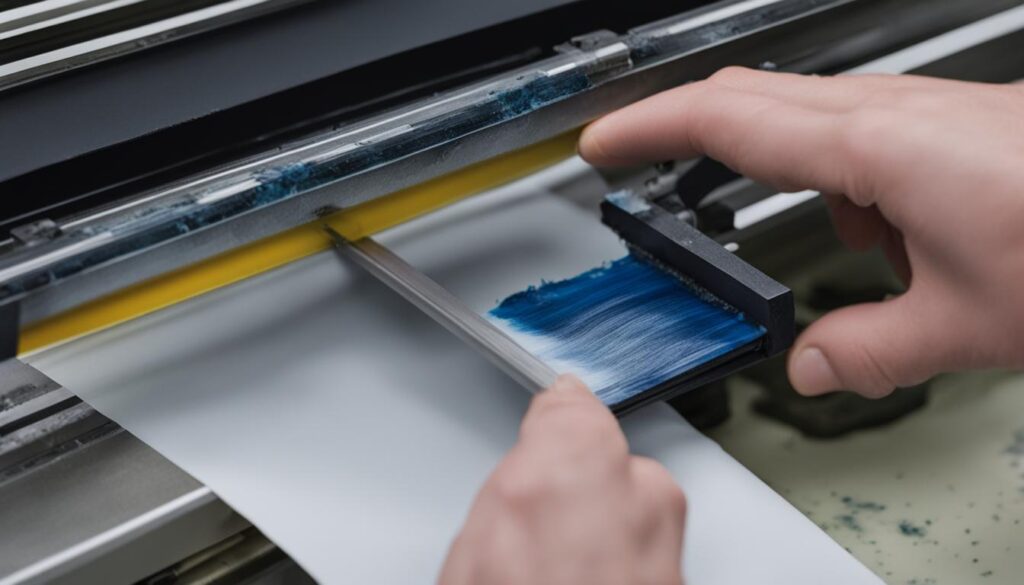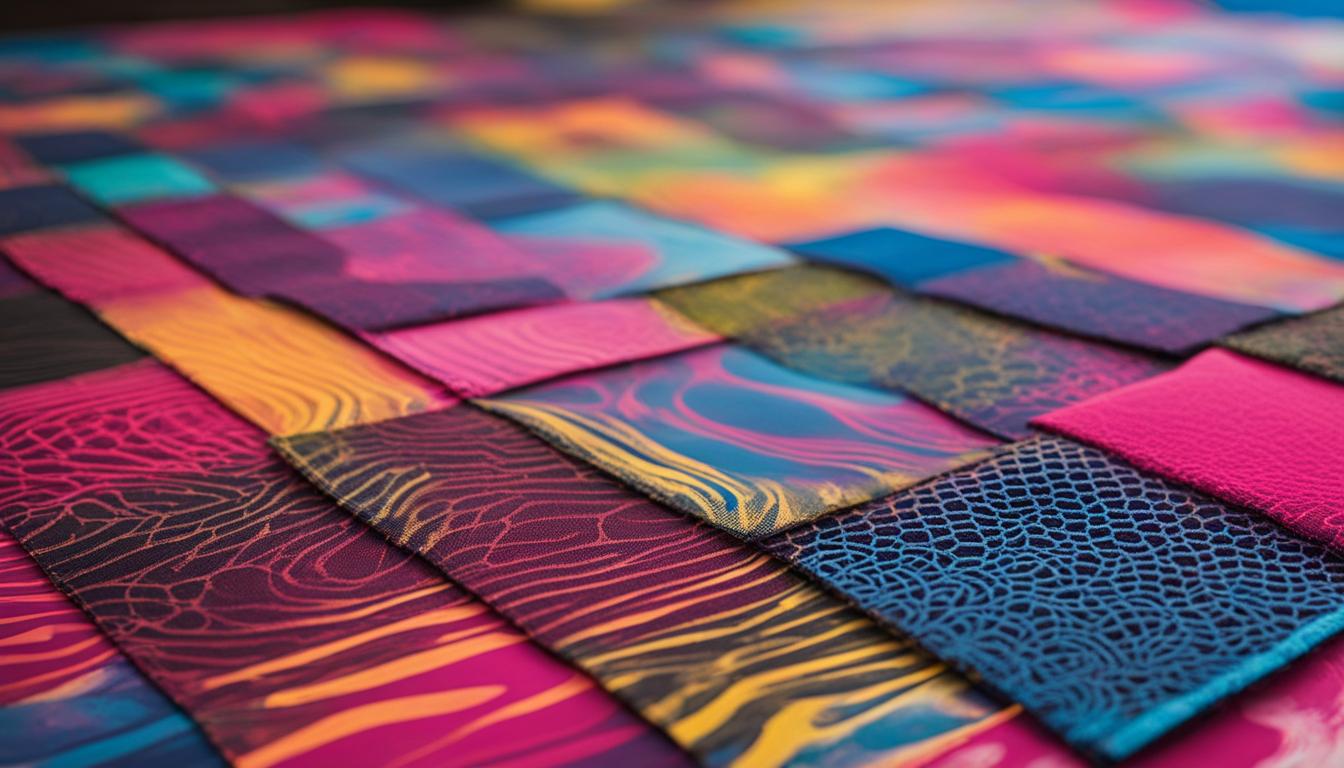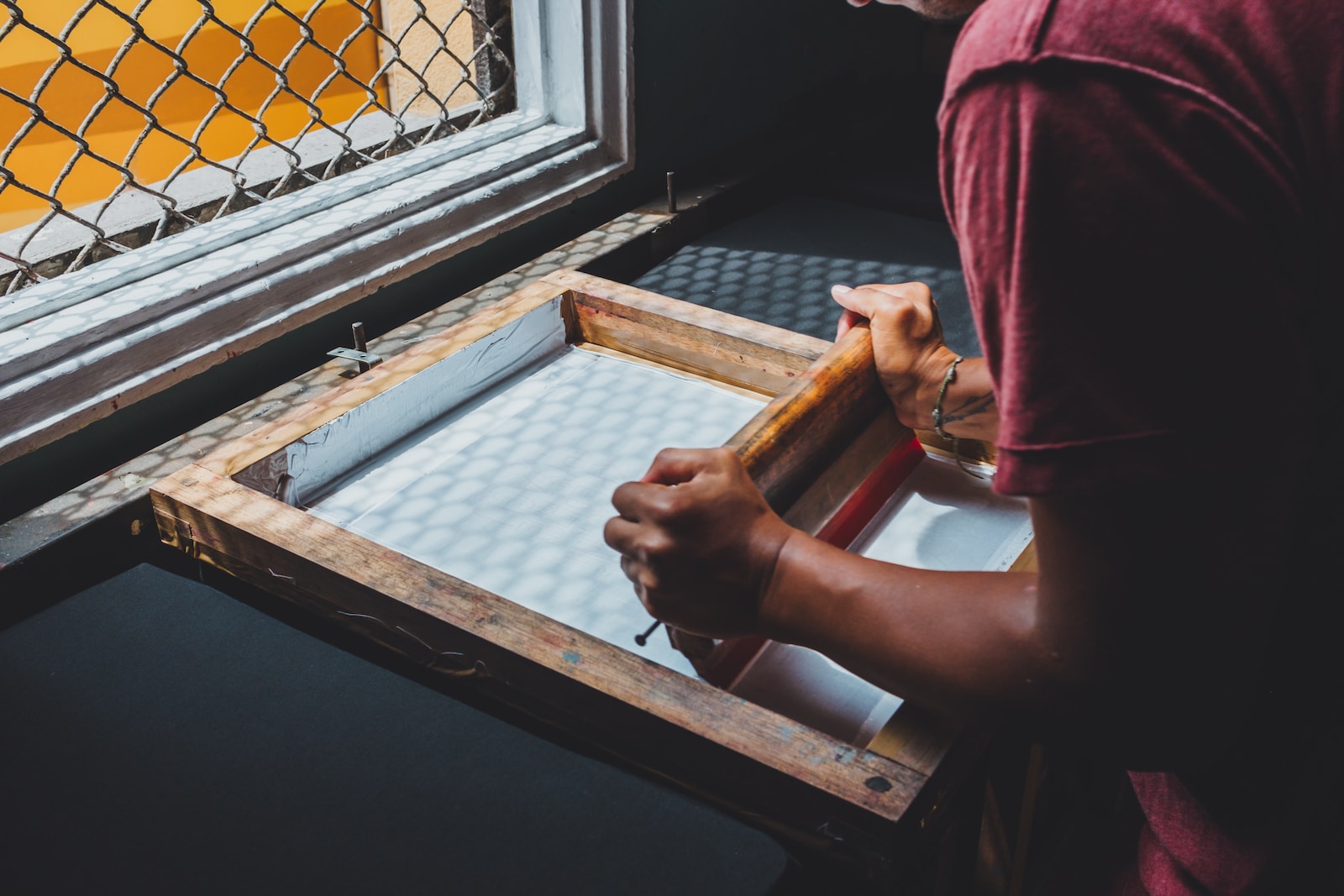Screen printing and heat transfer are two popular methods used to print logos and designs on T-shirts and other promotional garments. Both processes have their own unique characteristics and benefits. Understanding the differences between screen printing and heat transfer can help you make an informed decision when choosing the right printing method for your project.
Key Takeaways:
- Screen printing involves the use of a fine screen mesh to create a stencil, allowing vibrant, long-lasting colors that permeate the fabric.
- Heat transfer uses heat and pressure to transfer vinyl or digitally printed designs onto the fabric, providing customization and high-resolution images.
- Screen printing offers superior durability and is cost-efficient for larger quantities and simple designs.
- Heat transfer allows for customization, complex designs, and is more cost-effective for smaller quantities.
- The choice between screen printing and heat transfer depends on factors such as durability, image quality, and cost efficiency.
Screen Printing Process
Screen printing is a popular method used in the custom garment industry to create high-quality, vibrant designs. The process involves several steps to ensure precise and long-lasting results. Here is a breakdown of the screen printing process:
- Design Creation: The first step in screen printing is creating the design that will be printed onto the fabric. This can be done digitally or by hand, depending on the desired outcome.
- Stencil Preparation: Once the design is finalized, a stencil is created by coating a screen mesh with a light-sensitive emulsion. The emulsion is exposed to UV light through a transparency film of the design, hardening the emulsion in the areas where the design is present.
- Ink Mixing: Next, the ink colors are mixed according to the design specifications. This allows for custom color matching and ensures the desired vibrancy of the final print.
- Printing Process: The prepared stencil is then attached to a screen printing press. The fabric to be printed is placed beneath the screen, and ink is poured onto the stencil. A squeegee is used to evenly spread the ink across the stencil, forcing it through the mesh and onto the fabric.
- Drying and Curing: After printing, the fabric is dried or cured to set the ink. This can be done through air-drying or using a heat press, depending on the type of ink used.
One of the key advantages of screen printing is its ability to create multi-colored designs with precision. Each color in the design requires a separate screen, allowing for precise registration and vibrant color combinations. Additionally, the ink used in screen printing permeates the fabric, resulting in a durable print that can withstand repeated washing without fading or cracking. This makes screen printing an excellent choice for custom designs, logos, and multi-colored artwork.

| Factors | Screen Printing | Heat Transfer |
|---|---|---|
| Durability | High – ink permeates fabric | Medium – may peel or crack over time |
| Image Quality | Excellent – vibrant colors, precise details | Very good – high-resolution images |
| Cost Efficiency | Cost-effective for larger quantities | Cost-effective for smaller quantities |
By understanding the screen printing process and its advantages, you can make an informed decision when choosing the best printing method for your custom garments. Whether you need a multi-colored logo or a durable print that lasts, screen printing offers a reliable and high-quality solution.
Heat Transfer Process
The heat transfer process is a popular method for printing logos and designs on various fabrics. It offers the ability to create high-resolution images and intricate designs that are not easily achieved with other printing methods. The heat transfer process can be done using two main methods: vinyl and digital.
Vinyl heat transfer involves cutting letters and designs from colored vinyl sheets using a machine. These cutouts are then placed on the fabric and transferred using a heat press. The heat and pressure from the press bond the vinyl to the fabric, creating a durable and vibrant design. Vinyl heat transfer allows for customization and is often used for personalized apparel, such as team jerseys or promotional items.
Digital heat transfer, on the other hand, utilizes solvent ink to print logos and designs onto heat transfer paper. The printed heat transfer paper is then placed on the fabric and transferred using a heat press. This method is ideal for complex designs with multiple colors, gradients, or photographic images. Digital heat transfer provides exceptional image quality and reduces the time and materials needed for the process.
In summary, the heat transfer process offers versatility and the ability to create intricate designs on various fabrics. Whether using vinyl or digital methods, heat transfer allows for customization and high-resolution images. It is a popular choice for personalized apparel and promotional items.
Comparison of Screen Printing and Heat Transfer
When it comes to deciding between screen printing and heat transfer, there are several key factors to consider: durability, image quality, and cost efficiency. Let’s take a closer look at each of these elements to help you make an informed choice.
Durability
Screen printing is known for its exceptional durability. The ink used in the screen printing process permeates the fabric, resulting in long-lasting images that can withstand repeated machine washing without fading. On the other hand, heat transfer images, especially those created using vinyl, may not be as durable. Over time, the vinyl may peel or crack, especially with frequent washing and wear.
Image Quality
Both screen printing and heat transfer can produce high-quality images, but there are some differences to consider. Screen printing offers vibrant and bold colors that permeate the fabric, resulting in eye-catching designs. Heat transfer, particularly digital heat transfer, produces high-resolution images with fine details and gradients. This makes it an excellent choice for intricate designs and photographs. However, it’s important to note that heat transfer images may not have the same level of color vibrancy as screen-printed ones.
Cost Efficiency
Cost efficiency can vary depending on the project requirements. Screen printing is generally more cost-effective for larger quantities of items with simple designs. The setup costs for screen printing can be higher initially, but the per-unit cost decreases as the quantity increases. Heat transfer, on the other hand, is more cost-effective for smaller quantities and offers the advantage of customization. Additionally, heat transfer allows for multiple colors to be printed at once, reducing the overall cost for multi-colored designs.
| Screen Printing | Heat Transfer | |
|---|---|---|
| Durability | High | Medium |
| Image Quality | Vibrant colors, may fade over time | High-resolution, may lack color vibrancy |
| Cost Efficiency | Cost-effective for larger quantities | Cost-effective for smaller quantities and customization |
Ultimately, the choice between screen printing and heat transfer depends on your specific needs and priorities. If durability and vibrant colors are essential, screen printing is the way to go. On the other hand, if customization and high-resolution images are a priority, heat transfer is the better option. Consider the quantity of items, complexity of the design, desired durability, image quality, and cost efficiency to make the best decision.
Conclusion
When it comes to choosing between screen printing and heat transfer, there are several factors you need to consider. If you have larger quantities of items to be printed and simple designs, screen printing is the way to go. It offers superior durability and long-lasting images that can withstand machine washing, ensuring your designs stay vibrant for a long time.
On the other hand, if you have smaller quantities, customization needs, complex designs, or require high-resolution images, heat transfer is the better option. It allows for customization of individual shirts, and with digital heat transfer, you can achieve intricate designs and reduce the time and materials needed for the process.
Ultimately, the choice between screen printing and heat transfer depends on your specific requirements. Consider factors such as durability, image quality, and cost efficiency. By assessing the needs of each project, you can make an informed decision that will result in the best outcome for your printing needs.
FAQ
What is screen printing?
Screen printing is a method used to print logos and designs on fabric. It involves creating a stencil on a fine screen mesh and applying ink through the mesh onto the fabric.
How does heat transfer work?
Heat transfer uses heat and pressure to transfer vinyl or digitally printed designs onto fabric. Vinyl heat transfer involves cutting vinyl letters and designs and transferring them with a heat press. Digital heat transfer uses solvent ink to print logos onto heat transfer paper, which is then transferred to the fabric.
Which method is best for complex designs?
Heat transfer, particularly digital heat transfer, is ideal for complex designs because it allows for high-resolution images and the ability to print multiple colors at once.
Which method is more durable?
Screen printing is generally more durable as the ink permeates the fabric and can withstand machine washing. Heat transfer images may not be as long-lasting.
Which method is more cost-effective for larger quantities?
Screen printing is more cost-efficient for larger quantities and simple designs, as it allows for faster production and lower per-unit costs.
Which method is more cost-effective for smaller quantities?
Heat transfer, especially digital heat transfer, is more cost-effective for smaller quantities as it reduces the time and materials needed for the process.
Can I customize individual shirts?
Yes, heat transfer allows for customization of individual shirts, making it ideal for personalized designs or small orders.
Which method offers high-resolution images?
Digital heat transfer offers high-resolution images as it uses solvent ink to print logos and letters onto heat transfer paper.
What are the benefits of screen printing?
Screen printing offers vibrant, long-lasting colors that permeate the fabric, making it durable and suitable for simple designs with a few colors.
What are the benefits of heat transfer?
Heat transfer allows for customization, complex designs, and high-resolution images. It is also more cost-effective for smaller quantities and offers the ability to print multiple colors at once.
 Skip to main content
Skip to main content


